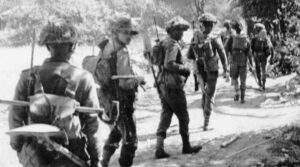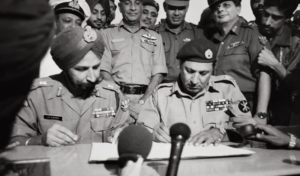by R. Chowdhury 12 March 2023
ও আমার বাংলাদেশ !
কারো দয়ায় নয় এই অর্জন
এ ছিল আমাদের একান্ত প্রাপ্য, একান্ত অধিকার
তুমি তো চিলে বহু দিনের লালিত স্বপ্ন!!
–জহিরুল (মুকুল)
Some pundits believe India liberated Bangladesh. Pro-Indian elements and their agents in Bangladesh, particularly the Awami League, also think so. That is the Indian concept, Indian narrative of the Indo-Pak War. On that pretext, India took the surrender of the defeated Pakistan military– to the exclusion of the Bangladesh liberation forces– on the soil still soaked by the blood of the Bengali martyrs. (The helicopter carrying General M A G Osmani, Chief of Mukti Bahini, the liberation forces, was force-grounded in Sylhet to keep him away from the ceremony). A betrayal to Bangladesh!
The surrender ceremony between Lieutenant General J S Aurora (India) and Lieutenant Amir Abdullah Khan Niazi (Pakistan) on December 16, 1971 in Dhaka.
Yet others think it was a Civil War in East Pakistan in 1971. That is the Pakistani narrative. The war started on the night of March 25, 1971 when the Pakistan military commenced its brutal Operation Searchlight, killing thousands of innocent Bengalis in the first sweep. Until March 27, it was perhaps a civil war. But once the Independence of Bangladesh was declared on March 27, 1971 by then Major Ziaur Rahman, it became the War of Independence or the Liberation war. If Pakistan survived, it could have been termed as a civil war and the independence fighters would have been paraded to the gallows.
I wish these history-experts and Indian sycophants were on the war fronts and understood the Bangladesh liberation war, much of which was unconventional in the beginning, — a hit-n-run, guerrilla style. Holding ground was neither sustainable nor contemplated until the conventional forces of the Mukti Bahini became operational by October/early November, 1971.
India joined the formal conflict on December 4, 1971, only to see its end in a few days. Before that, India was in a supporting role providing logistics and sanctuary to the freedom fighters. At times, Indian forces did provide some limited fire support from behind.
(J N Dixit explains in his book that Prime Minister Indira Gandhi was in Kolkata on December 3, 1971 to formalize the Joint Command for Eastern Sector with Generals J S Aurora and Osmani, when Pakistan bombed nine targets inside western India, including Agra. Gandhi was rushed through a clandestine route to New Delhi, where she declared war with Pakistan the next day).
The geopolitical scenario in 1971 was complicated; many forces and vested players had their roles in South Asia. In sharing the thoughts of Zoglul Husain, a political analyst and winner of the Freedom Award for his work since 1957, I may sum up as follows: 1) Pakistan wanted to crush the “rebellion” in East Pakistan to continue its domination there. It had the US, China and some Arab countries to its side. 2) India’s support for the Bengali freedom fighters emanated from its newfound opportunity of lifetime to divide Pakistan and keep a separated Bangladesh as its much-needed colony, a dream it had espoused since 1947 (Confirmed by J N Dixit, a former Indian Foreign Secretary, in his book Liberation and Beyond). It acquired Russian support. 3) The patriotic freedom fighters fought to liberate themselves from the Pakistani overlordship of 23 years and create an independent, democratic and socially harmonious Bangladesh. After the military crackdown on March 25 and the declaration of independence two days later, there was turning back. They enjoyed the support of the freedom loving people from around the world. They won on December 16, 1971.
Being a humble freedom fighter, I have seen how our fighters fought and died for Bangladesh. Not giving credit to them by some ‘know-all’s is their choice, but I think it is an insult not only to the living fighters but also to the martyrs of war and the defiled thousands of women by the enemy. There might be some paper-fighters, as in any independence war, but that does not erase the contribution and bloodletting of the true fighters.


